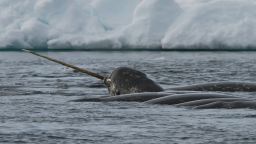It was a mystery for nearly 30 years.
A hunter turned over a whale skull that appeared to share the characteristics of both a beluga whale and a narwhal.
Scientists were stumped.
But, years after revisiting the anomaly, a group of Danish researchers decided it was a hybrid whale all along.
The unique skull, they say, was the result of a forbidden romance between a narwhal mother and a beluga father.
It’s the only known evidence of a hybrid between the two Arctic whales, they wrote, in a study was published Thursday in the journal Science Reports.
Researchers recovered the skull in 1990 from a hunter who caught the whale in West Greenland’s Disko Bay. He described the whale as gray in color with the short, round pectoral flippers of a beluga whale and the streamlined fluke, or tail, of a narwhal.
The skull was larger than those of its presumed parents, and its teeth, positioned horizontally, didn’t belong to either species.
The hunter also captured two other similar-looking whales, though no samples remained of them.
The skull sat unidentified at the National Museum of Denmark at the University of Copenhagen for years, until researchers took it up again.

To settle the whale’s parentage once and for all, researchers analyzed the skull’s DNA sequences against those of eight belugas and eight narwhals and the tooth and bone samples from both.
The skull, they decided, belonged to a male hybrid – a first-generation hybrid based on the 50-50 split of his DNA.
His teeth helped scientists ID the whale, too: Male narwhals only have one tooth, which takes the form of its famous tusk, protruding through its lip and out up to 8 feet.
Male belugas, meanwhile, can fit up to 40 teeth.
While the Arctic’s only two-toothed whale species share the same migratory patterns, opting to partner up in the spring after the sea ice breaks up and traveling to their summering grounds, not much else is known about their secretive breeding processes.
But in Disko Bay, both species congregate in large numbers during mating season and individuals in both species have been spotted traveling with the pods of the other. Cross-species mating, while never before recorded, may be a rare occurrence.
It’s already earned the nickname “narluga.” And of course it happened in Disko Bay.
